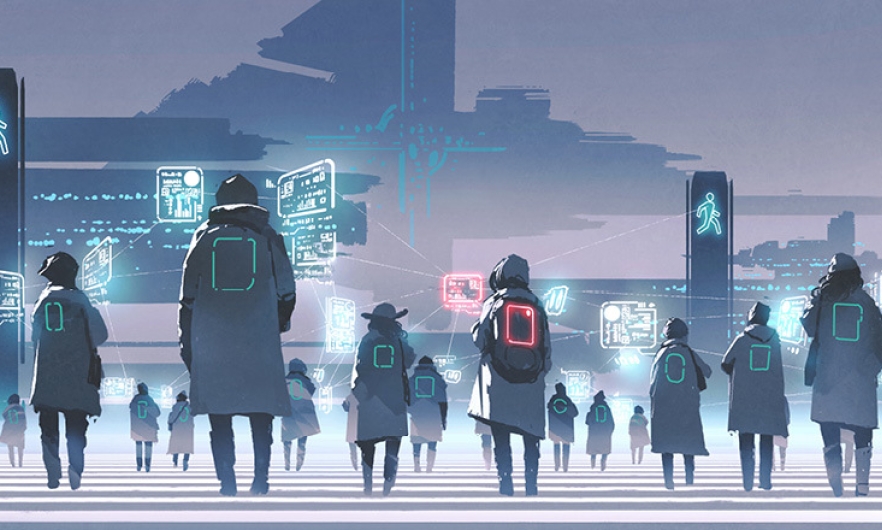Contact-Tracing Technology: A Key to Reopening

Contact tracing has been a critical public health practice for decades.
Identifying people sickened by infectious diseases, isolating them, and then identifying and quarantining people they came into contact with breaks disease transmission chains and quells outbreaks.
This practice—implemented by a robust workforce and bolstered by digital tools—will be central to safely reopening U.S. schools and businesses, according to a recent report by the Johns Hopkins Center for Health Security. In this Q&A, Crystal Watson, DrPH, a lead author of the report, explains why technology is vital to contact tracing efforts and how it might work. Watson is a senior scholar at the Center and an assistant professor in Environmental Health and Engineering.
What would contact tracing look like without this technical technological support?
Public health does contact tracing all the time for other infectious diseases like sexually transmitted infections and tuberculosis ... They use technologies for that, too—mainly to collect information from people about their symptoms and who they were in contact with.
The technology we need for contact tracing for the novel coronavirus is more about trying to understand how many people a person has been [close to] if they don’t know those people.
We will be able to connect with most contacts of a person who’s been sick by just interviewing them and asking them who they’ve been around. But technology really helps when public health workers need to look for contacts in places that may be more crowded, or when the identified person doesn’t know the people they came into contact with. Say you go to the grocery store, and you’ve been within 6 feet of a number of people but you don’t know who those people are. Typically in public health we’ll have to do some real detective work to identify those people, and it may not always be possible. That’s where technologies can help—in identifying those people who might otherwise not know that they were exposed.
What might this technology look like?
We would want something that gives us pretty fine-grained information about how close a person was to another person—what that environment was, how long they were there together. If we were to get that much information out of a technology, that would be extremely useful for public health. Obviously we would also want that technology to protect the identities and privacy of the people who might be contacts of an identified case. We wouldn’t want their identity to be compromised and put out in the public or their information to be sold and used for other purposes.
We need that combination of security and protection of privacy but with a really fine-tuned ability to identify someone within even a couple of feet. I’m not sure we can get there with existing technologies. Bluetooth can’t get us into that 6 feet of geographic space that we want, but is more protective of privacy. GPS might get us closer to the resolution that we want, but the data is more identifiable.
This technology would depend on smartphones?
I think those are mostly what we would rely on. There are other types of surveillance that were done in China, for example, that I don’t think we would want here. I think we would rely on the fact that you’re probably carrying your cell phone. With a contact tracing mobile app installed, that would help us catch most contacts.
If we had that technology, would we still need the workforce of 100,000 contact tracers your team’s recent report calls for?
The technology on its own really can’t do the job. We need people who can ask questions and try to understand the type of exposure that might have occurred because not all exposures are equal.
If you just ask someone who they were in contact with, that doesn’t provide the whole story. You need to ask who they were in very close contact with and what that contact was like: How long was it? Did you actually make physical contact with someone, or were you just standing within 6 feet, and for how long? You would then need to ask similar questions of those contacts about what they recall of the situation. Answers to those questions will help us determine if someone actually needs to be quarantined for two weeks, and that’s important because it’s a big ask.
A combination of the increased workforce and technologies as a force multiplier for identifying unknown contacts is required for this effort to work.
Are you optimistic that we’ll get technology up and running in order to be able to use it effectively for this epidemic?
I am optimistic because we’ve seen it elsewhere in the world, such as in Iceland and New Zealand. We know that it can happen. We have also seen a tremendous amount of interest and a feeling of wanting to give back and provide a solution from technology companies around the country. What we need is national coordination of these efforts to make sure that any adopted technologies actually help public health workers in their work and don’t make it harder to do, and also that they protect privacy.
We will need to communicate with the public as well to explain why we’re making these efforts, why we need to do contact tracing. They need to understand what it means for their own health and safety as well as the health and safety of their communities and their loved ones.
Melissa Hartman is managing editor of Hopkins Bloomberg Public Health magazine.
RELATED
"Identify Every Case"—Successful Contact Tracing and What it Will Take to Reopen the US—Public Health On Call Podcast, April 16, 2020





